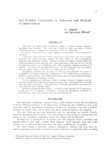Soil Fertility Constraints in Indonesia and Methods of Improvement
Tropical agriculture research series : proceedings of a symposium on tropical agriculture researches
| ISSN | 03889386 |
|---|---|
| NII recode ID (NCID) | AA00870529 |

Full text
tars24-_69-78.pdf1.66 MB
The major soil orders found in Indonesia consist of Ultisols, Oxisols, Histosols, Inceptisols and Vertisols. The total area covered by these soil orders is about 130million hectares or slightly more than 68% of the total land area.
Soil fertility constraints have a major influence on distribution of the population in Indonesia.
Constraints associated with Ultisols and Oxisols result from a low level of plant nutrients, low cation exchange capacity and high acidity as well as phosphorus deficiency and aluminium toxicity. Liming is needed for bulldozer-cleared lands and lands cultivated for more than one year. Lime application at the rate of 0.3 to 1.0t/ha is needed for upland rice in bulldozed soils, while mungbaen requires as much as 5t lime/ha. The critical Al-saturation levels are : 5 % for mungbean, 15% for soybean, 28% for peanut, 29% for corn, 55% for cowpea and 70% for rice.
Phosphorus fertilizers are necessary to overcome the extremely low levels of available P in Ultisols and Oxisols. Applications of 20 to 80kg P/ha are sufficient to fertilize crops in rotation. The residual effect lasts at least two years and the economic return of phosphorus fertilization is high.
For the reclamation of Histosols, shallow drainage ditches at frequent intervals are more suitable than relatively few deep drainage canals. Lime application is needed when pH values are below 4. The application of nitrogen, phosphorus, potassium and trace elements gives striking results.
Andosols are high phosphate fixers. To achieve a high efficiency for P application, a high rate of P is suggested. Although in Vertisols the phosphorus availability is generally low, there is no fertilize each crop with phosphorus.
Soil fertility constraints have a major influence on distribution of the population in Indonesia.
Constraints associated with Ultisols and Oxisols result from a low level of plant nutrients, low cation exchange capacity and high acidity as well as phosphorus deficiency and aluminium toxicity. Liming is needed for bulldozer-cleared lands and lands cultivated for more than one year. Lime application at the rate of 0.3 to 1.0t/ha is needed for upland rice in bulldozed soils, while mungbaen requires as much as 5t lime/ha. The critical Al-saturation levels are : 5 % for mungbean, 15% for soybean, 28% for peanut, 29% for corn, 55% for cowpea and 70% for rice.
Phosphorus fertilizers are necessary to overcome the extremely low levels of available P in Ultisols and Oxisols. Applications of 20 to 80kg P/ha are sufficient to fertilize crops in rotation. The residual effect lasts at least two years and the economic return of phosphorus fertilization is high.
For the reclamation of Histosols, shallow drainage ditches at frequent intervals are more suitable than relatively few deep drainage canals. Lime application is needed when pH values are below 4. The application of nitrogen, phosphorus, potassium and trace elements gives striking results.
Andosols are high phosphate fixers. To achieve a high efficiency for P application, a high rate of P is suggested. Although in Vertisols the phosphorus availability is generally low, there is no fertilize each crop with phosphorus.
| Date of issued | |
|---|---|
| Creator | M. Sudjadi Suryatna Effendi |
| Publisher | Japan International Research Center for Agricultural Sciences |
| Volume | 24 |
| spage | 69 |
| epage | 78 |
| Language | eng |
